Why Does My Oil Light Come On When I Brake?
Experiencing your oil light coming on when you break is always concerning for any car owner. Ignoring this warning light leads to severe engine damage. Which is why it’s essential to understand the root causes and potential solutions.
So why does my oil light come on when I brake? Some common causes are:
- Oil leaks
- Worn-out Engine Components
- Faulty oil pressure sensor
- Bad oil pump
- Dirty or clogged oil filters
Continue reading as we discuss the reasons behind the oil light activation. Also, discuss how to fix the issue to ensure your vehicle’s longevity and optimal performance.
Why Your Oil Light Comes On During Breaking: Overview Of The Causes And Solution

| Causes | Solutions |
|---|---|
| Oil leaks | Inspect any signs of leak and fix immediately |
| Worn out engine components | Consult professional mechanic |
| Replace worn engine components | |
| Faulty oil pressure sensor | Replace the damaged sensor with the help of a professional mechanic |
| Bad oil pump | Replace bad oil pump |
| Change bad oil. | |
| Dirty or clogged oil filters | Regularly replace the engine oil filter |
Why Does My Oil Light Come On When I Brake?
The oil light serves as a vital communication tool between the vehicle’s engine and the driver. Its primary purpose is to monitor the engine’s oil pressure and notify the driver if it drops below a safe level.
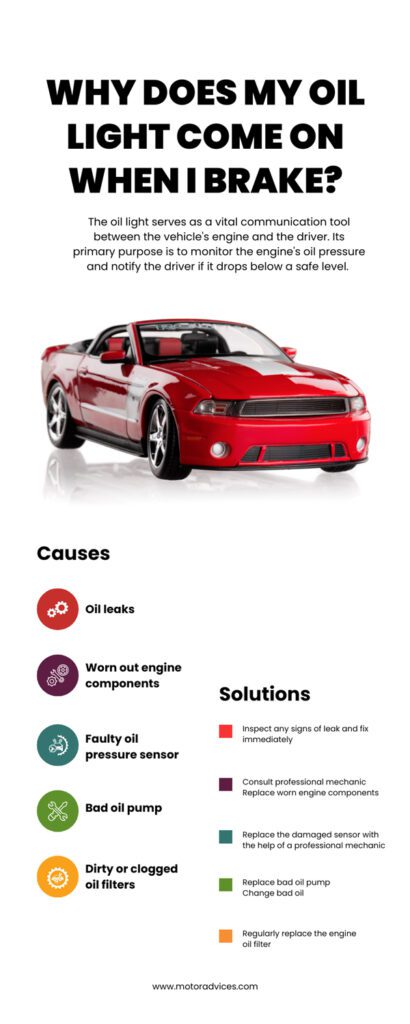
Adequate oil pressure is crucial for the engine’s smooth operation, as it
- Lubricates moving parts
- Reduces friction
- Dissipates heat
Here are potential reasons for the oil light coming on.
1. Oil Leak
An oil leak will lead to a drop in the engine’s oil level, resulting in insufficient oil pressure when you brake.
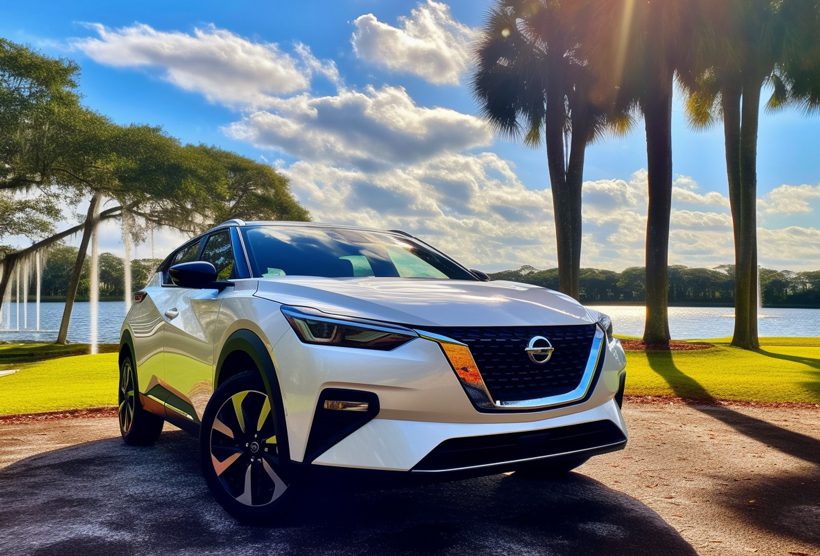
How To Fix
- Inspect the engine for any signs of oil leaks. If you find a leak, identify its source and have it repaired by a qualified mechanic.
The oil leak can be inspected by following the process.
- Park the car on a level surface. This will allow you to identify any oil leaks more accurately.
- For safety reasons, wait for the engine to cool down. A hot engine can cause burns or injuries.
- Place a clean cloth or a piece of cardboard under the engine area where you suspect the leak might be occurring. This will help you identify any fresh oil drips or stains.
- Inspect the Engine Components, such as the valve cover, oil pan, and oil filter, for signs of oil leaks. Check for any wet or oily spots around these areas.
- Pull out the engine’s oil dipstick and inspect it for any visible oil leaks or stains.
- Keep track of your engine oil levels regularly to ascertain any sudden drop in oil.
- Take note of the burning smell and unusual engine sound, which indicates an oil leak.
- Check the color of the oil by drops on a sheet of white paper. The engine oil is amber, feels thin and slippery, and has a strong chemical odor.
- Ensure you maintain the recommended oil level by checking it regularly and topping it up as needed. The recommended oil level for vehicles varies depending on the make and model of the car.
This is usually between the two marks on the dipstick. If the oil level is between the double lines, the vehicle has sufficient oil. If it’s below the mark, add some oil to top it up.
2. Faulty Oil Pressure Sensor
The oil pressure sensor monitors the engine’s oil pressure and triggers the oil light when it detects low pressure. If the sensor malfunctions, it may incorrectly activate the oil light.
A decrease in oil pressure of around 10 psi per 1,000 RPMs is a normal occurrence. However, this decline might lead to inaccurate calculations of an acceptable range by a malfunctioning oil pressure sensor during braking.
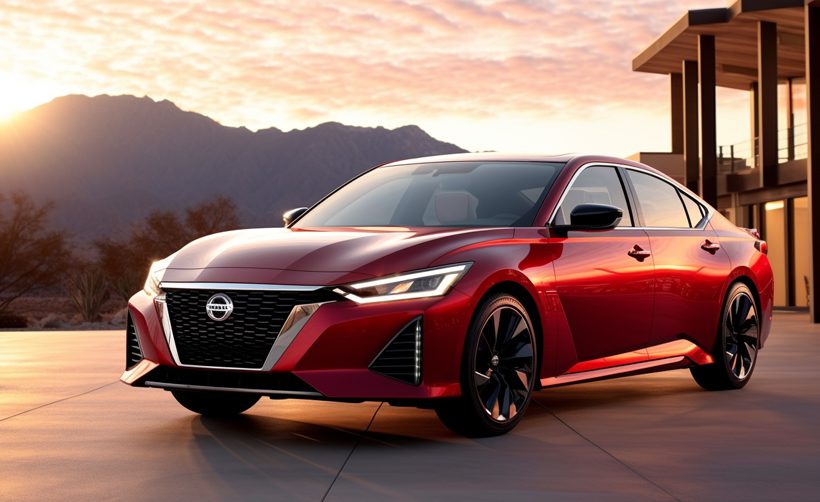
How to Fix it?
- Consult a professional mechanic for proper diagnosis and replacement.
- Replace the damaged sensor if necessary.
Tools needed for the replacement are:
- New oil pressure sensor
- Wrench set or socket set
- Thread sealant (if required)
- Shop towels or rags
- Safety glasses
Here’s a step-by-step guide to replacing the oil pressure sensor
- Step 1. Park the vehicle on a flat surface and engage the parking brake.
- Step 2. Let the engine cool down before starting.
- Step 3. Locate the oil pressure sensor near the oil filter or oil pan.
- Step 4. Disconnect the negative terminal of the battery for safety.
- Step 5. Place shop towels or rags around the sensor area.
- Step 6. Loosen and remove the old oil pressure sensor using a wrench or socket.
- Step 7. If needed, apply thread sealant to the threads of the new sensor.
- Step 8. Hand-thread the new sensor into place, then gently tighten it using a wrench.
- Step 9. Reconnect the negative terminal of the battery.
- Step 10. Start the engine and check for any oil leaks around the new sensor.
- Step 11. Observe the oil pressure gauge or warning light to ensure it’s normal.
- Step 12. Allow the engine to run for a few minutes and recheck for leaks.
- Step 13. Clean the work area and wipe away any excess oil.
If the oil light continues to come on after taking these initial steps, it’s essential to seek the expertise of a qualified mechanic.
3. Bad Oil Pump
Your car oil pump is vital for maintaining proper oil pressure throughout your engine. A failing or malfunctioning oil pump will lead to a drop in oil pressure, causing the oil light to come on when you brake.
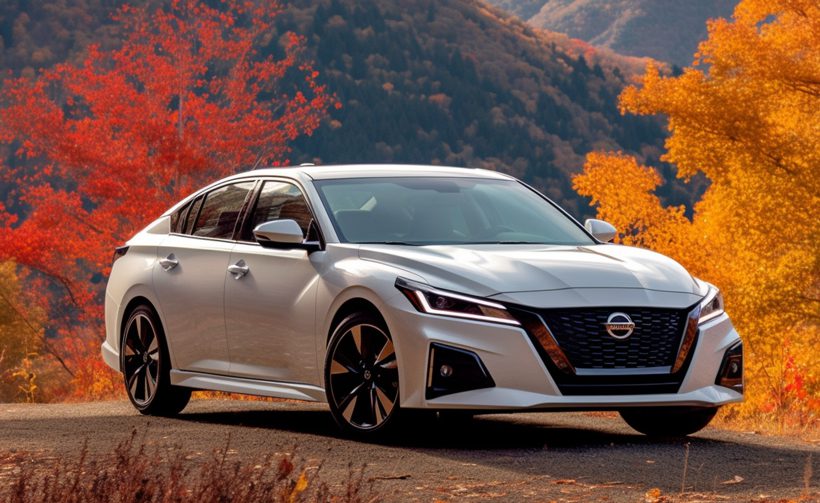
Symptoms of Bad Oil Pump
- Low oil pressure warning light on the dashboard
- Unusual engine noises like knocking or ticking
- Consistently low or fluctuating oil pressure gauge readings
- Lack of proper lubrication results in excessive engine noise and wear
- Engine temperature rising due to inadequate cooling
- Excessive oil leakage or pooling in the engine compartment
How To Fix
- Repair or replace a bad oil pump. It’s best to seek the expertise of a qualified mechanic to assess the oil pump’s condition and carry out the necessary repairs.
- Ensure you’re not overdue for an oil change, as degraded oil loses its pressure capability. Consequently, making the oil warning light to illuminate.
4. Worn Engine Components
Oil leaks occur for various reasons, ranging from normal wear and tear to more serious mechanical issues. These worn-out parts decrease oil pressure when the engine RPM drops during braking, causing the oil light to illuminate.
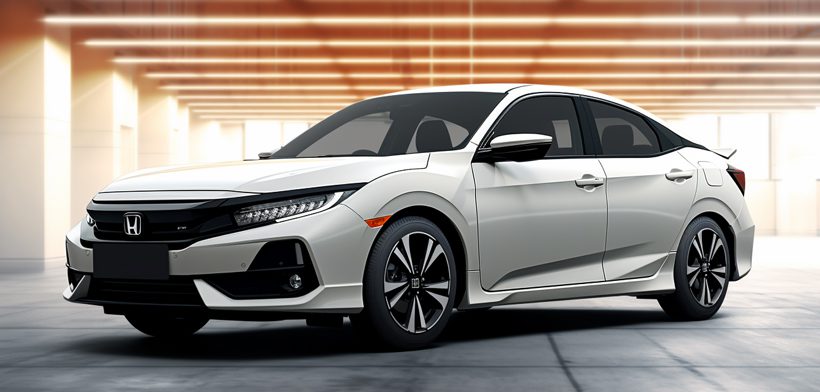
Here are common causes of oil leaks
- Worn or deteriorated gaskets and seals
- Loose or improperly sealed components
- Degraded engine parts such as valve covers and oil pans
- Excessive oil pressure due to a malfunctioning oil pump
- Physical damage from road debris or collisions
- Incorrect installation of gaskets or seals
- Overfilling oil during an oil change
- Coolant contamination from a damaged cylinder head gasket
- Aging or worn rubber hoses
How to Fix
- Addressing this issue requires a thorough engine inspection by a professional mechanic.
- Replace worn-out components, which depend on the extent of wear.
5. Dirty or Clogged Oil Filters
The engine oil filter can sometimes become clogged with dirt, debris, and contaminants. A clogged filter restricts oil flow, leading to reduced oil pressure during braking, which triggers the oil light.
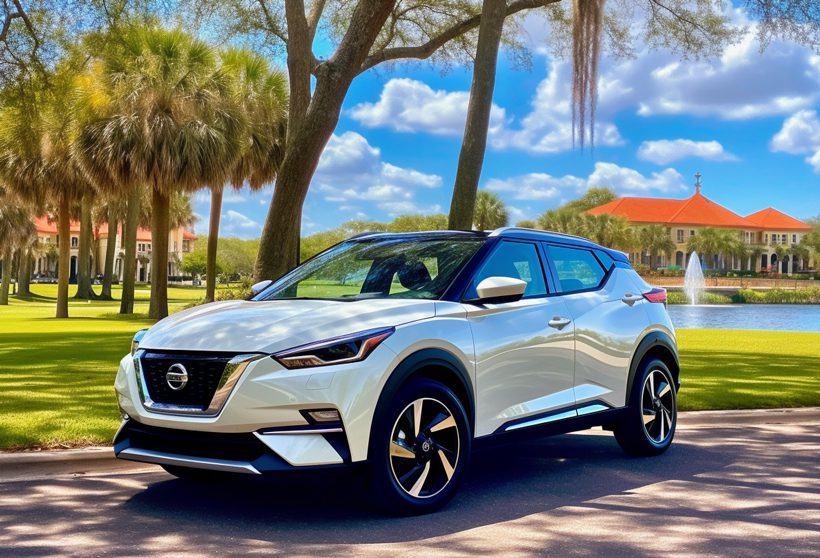
How to Fix
- Regularly replace the engine oil filter as part of your routine maintenance. Take your car to an auto mechanic shop to have it fixed by an expert.
FAQs
Here are questions people also ask on why my oil lights come on when I brake and the answers to them.
Driving at high speeds causes the oil light to come on temporarily when braking due to rapid engine RPM changes.
Releasing the brake pedal allows the engine RPM to increase, which can restore oil pressure and turn off the oil light.
It’s advisable to check your engine oil level regularly, at least once a month, to ensure it remains within the recommended range and prevent oil pressure issues.
Final Word
Whenever your oil light comes on when you brake, it is essential not to overlook the warning. Low oil pressure can result from leaks, faulty sensors, bad oil pumps, or worn engine components.
Regular maintenance, prompt repairs, and seeking professional help when needed are very important. This will ensure the optimal performance of your vehicle’s engine. Always prioritize the safety and longevity of your car by addressing any oil pressure concerns promptly.

